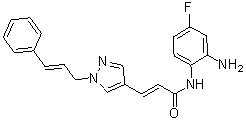
RGFP966 is an HDAC3 inhibitor with IC50 of 0.08 μM, exhibits > 200-fold selectivity over other HDAC. Systemic treatment with RGFP966 facilitates extinction in mice in a manner resistant to reinstatement. A single treatment of RGFP966 enhances extinction of a previously established cocaine-conditioned place preference, while simultaneously enhancing long-term object-location memory within subjects. HDAC3 inhibition using a first in class selective inhibitor, RGFP966, resulted in decreased cell growth in CTCL cell lines due to increased apoptosis that was associated with DNA damage and impaired S phase progression. Selective inhibition of HDAC3 could be useful in treatment of CTCL by disrupting DNA replication of the rapidly cycling tumor cells, ultimately leading to cell death.
Another CAS# 1396841-57-8

Cell Death Differ. 2023 Mar 9.
Targeting HDAC3 to overcome the resistance to ATRA or arsenic in acute promyelocytic leukemia through ubiquitination and degradation of PML-RARα
RGFP966 purchased from AbMole

Inflamm Res. 2022 Dec;71(12):1547-1557.
C/EBPβ enhances immunosuppression activity of myeloid-derived suppressor cells by a P300-mediated acetylation modification
RGFP966 purchased from AbMole

University of Otago. 2019.
Transcriptional effects of mood stabiliser drugs in a serotonergic cell line
RGFP966 purchased from AbMole
| Molecular Weight | 362.4 |
| Formula | C21H19FN4O |
| CAS Number | 1357389-11-7 |
| Solubility (25°C) | DMSO 55 mg/mL |
| Storage |
Powder -20°C 3 years ; 4°C 2 years In solvent -80°C 6 months ; -20°C 1 month |
| Species | Mouse | Rat | Rabbit | Guinea pig | Hamster | Dog |
| Weight (kg) | 0.02 | 0.15 | 1.8 | 0.4 | 0.08 | 10 |
| Body Surface Area (m2) | 0.007 | 0.025 | 0.15 | 0.05 | 0.02 | 0.5 |
| Km factor | 3 | 6 | 12 | 8 | 5 | 20 |
| Animal A (mg/kg) = Animal B (mg/kg) multiplied by | Animal B Km |
| Animal A Km |
For example, to modify the dose of Compound A used for a mouse (20 mg/kg) to a dose based on the BSA for a rat, multiply 20 mg/kg by the Km factor for a mouse and then divide by the Km factor for a rat. This calculation results in a rat equivalent dose for Compound A of 10 mg/kg.
| Related HDAC Products |
|---|
| Ac-Arg-Gly-Lys(Ac)-AMC
Ac-Arg-Gly-Lys(Ac)-AMC is a substrate for HDAC. |
| Chlamydocin
Chlamydocin, a fungal metabolite, is a highly potent HDAC inhibitor, with an IC50 of 1.3 nM. |
| HDAC-IN-30
HDAC-IN-30 is a novel multi-target HDAC inhibitor, including HDAC1 (IC50=13.4 nM),HDAC2 (IC50=28.0 nM), HDAC3 (IC50=9.18 nM), HDAC6 (IC50=42.7 nM), HDAC8 (IC50=131 nM). |
| Ac-Arg-Gly-Lys(Ac)-AMC acetate
Ac-Arg-Gly-Lys(Ac)-AMC acetate is a substrate for histone deacetylase (HDAC) and can be used in a novel fluorescent assay for HDAC activity. |
| JPS014 TFA
JPS014 TFA is a benzamide-based Von Hippel-Lindau (VHL) E3-ligase proteolysis targeting chimeras (PROTAC). |


Products are for research use only. Not for human use. We do not sell to patients.
© Copyright 2010-2023 AbMole BioScience. All Rights Reserved.
